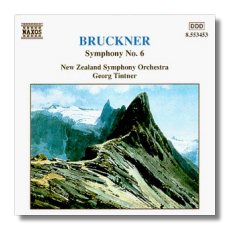
The Internet's Premier Classical Music Source
Related Links
- Bruckner Reviews
- Latest Reviews
- More Reviews
-
By Composer
-
Collections
DVD & Blu-ray
Books
Concert Reviews
Articles/Interviews
Software
Audio
Search Amazon
Recommended Links
Site News
 CD Review
CD Review
Anton Bruckner

- Symphony #2 in C minor (1872 version ed. Carragan)
National Symphony Orchestra of Ireland/Georg Tintner
Naxos 8.554006 71:22


- Symphony #5 in B Flat Major
Royal Scottish National Orchestra/Georg Tintner
Naxos 8.553452 76:46


- Symphony #6 in A Major
New Zealand Symphony Orchestra/Georg Tintner
Naxos 8.553453 59:47
These are the first three entries in Naxos' Bruckner cycle, which features Georg Tintner, an eighty-year-old Viennese-born conductor, until now virtually unknown to the average concertgoer and record collector. How he emerges as a major interpreter of the music of Anton Bruckner at this stage in his career is a miracle of this modern age. His previous obscurity is rather easy to explain: when the insanity of Hitler had reached Austria in 1938 (via the so-called Anschluss), Tintner fled, eventually arriving in New Zealand, and later settling in Australia (1954). Neither of these countries can hardly be described as the Mecca of classical music concert activity, though Tintner remained quite active within them. In 1987, following a stint at the English National Opera, he moved to Canada to assume duties as Music Director of the Symphony Nova Scotia. Somehow, he came to the attention of Naxos (certainly not least because he had become a widely respected Brucknerian), and the result is this on-going cycle of the Bruckner symphonies.
The three ensembles here all perform admirably for Tintner. I especially like the Dublin-based group and am happy to report that Tintner has also recorded Symphony #8 and the so-called Symphony #0 with them. The equally impressive Royal Scottish National Orchestra, however, dominates this series: they've already done Symphonies 4, 7, and 9, and will tape #1 and 3 and the Symphony in F minor, all with Tintner, of course. The masses are also to be recorded, though with whom and when I cannot say.
Overall, this conductor manages to obtain a fairly similar sound from the three ensembles here, though the Dubliners exhibit a richer string sonority and a bit more suavity. With generally moderate tempos, and fairly straightforward readings, Tintner's insightful grasp of the Brucknerian idiom never seems to falter. To many, his interpretive style will call to mind that of Günter Wand in these works, rather than those of the more pointed and muscular Barenboim and Jochum.
In the Second he does not attempt to plumb the depths to find the more profound Bruckner of the symphonies to come. He captures the beauties of this underrated score (in its recently unearthed original version) and delivers its robust and heroic sides in proper measure. All in all, he renders this symphony in just about the best possible light imaginable.
In the Fifth, he serves up a reading that balances the majestic with the subtle, always eschewing any tendency to go over the top, or to wallow in the score's seductive beauties. Most importantly, he demonstrates a fine sense of structure here, without which all talent for phrasing and highlighting of crucial detail would be squandered. In the end, he gives you a multi-faceted Bruckner, unbridled by any self-righteous inspiration to view the music in some new or extreme way. From the quiet pizzicato-bass opening of the first movement on to the glorious, brass-dominated ending of the finale, you hear Bruckner neither fettered by mannerism nor inflated by pomposity, but rendered judiciously yet compellingly.
Though many view the Sixth as a step backward for Bruckner, it emerges here, at least to me, as a great work, perhaps the equal of the other symphonies in latter half of the set. Again, Tintner's unerring grasp of structure and his sagacious sense of phrasing never seem to detour the musical trajectory. The beautiful second movement especially took me, though I did wish for a creamier, fuller string sound.
The sonics are quite fine throughout, and the copious notes, written by Tintner himself, are not only informative and scholarly, but give the reader uncommon insight into the mind of the conductor. He is frank, for example, in admitting his belief that the finale of the Sixth is flawed. He also confesses to inserting a fifteen-bar reduction from forte to mezzo-forte for most of the orchestra in the ending of the Second to achieve a truer balance in the sound. All in all, these three releases mark a most auspicious beginning to an important cycle and constitute, at Naxos' budget price, exceptional bargains.
Copyright © 1998, Robert Cummings


















